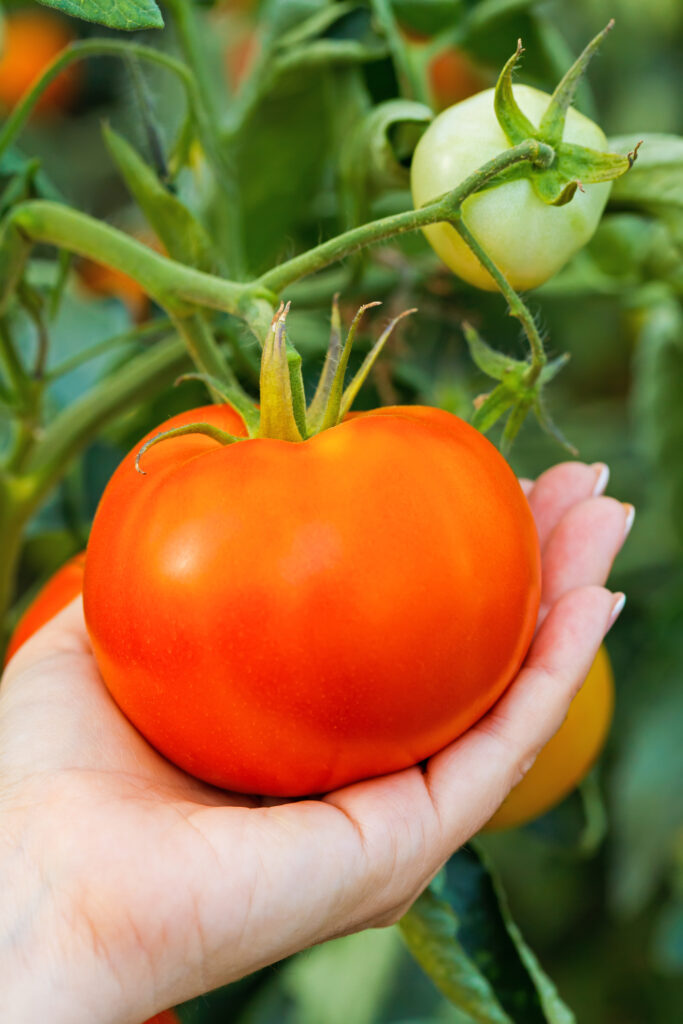
Are you ready to grow some tomatoes?! The season’s here and this article will show you everything you need to know to pick the right tomato for your garden.
By some estimates, 95% of home gardens include tomato plants! Which means that most of your gardening friends are already fussing and fretting over growing the best, the biggest, the juiciest, the reddest, and the sweetest tomato. Whatever your goal, tomatoes are truly a summertime jewel and the most versatile veggie for the dinner table. Nothing quite beats the taste of a thick slice of tomato on a warm summer evening – except for a delicious, hearty tomato sauce in the dead of winter made with your homegrown tomatoes.
 Sometimes choosing the right variety, though, can be totally overwhelming. With so many choices out there, many of us just cross our fingers and pick the prettiest plant! The type of tomato you choose starts with how you plan to use the produce. If you’re going to make salsas or sauces, choose a tomato with a meaty flesh as these hold up well when cooking, canning, or freezing. If you’re planning on eating them fresh off-the-vine, choose a salad or cherry tomato that has a bit higher water content and is usually sweeter. Many varieties in the beefsteak category fit both of these bills so are a good choice all around. Your growing space also determines what type of plant to buy as some of the heirloom varieties can require a lot of room to grow well.
Sometimes choosing the right variety, though, can be totally overwhelming. With so many choices out there, many of us just cross our fingers and pick the prettiest plant! The type of tomato you choose starts with how you plan to use the produce. If you’re going to make salsas or sauces, choose a tomato with a meaty flesh as these hold up well when cooking, canning, or freezing. If you’re planning on eating them fresh off-the-vine, choose a salad or cherry tomato that has a bit higher water content and is usually sweeter. Many varieties in the beefsteak category fit both of these bills so are a good choice all around. Your growing space also determines what type of plant to buy as some of the heirloom varieties can require a lot of room to grow well.
Of course, the world of tomato growing involves a bit more detail than whether a tomato is meaty or viney and you’ll encounter a few technical terms on plant labels. These terms include:
- Determinate vs. Indeterminate. Determinate tomato vines produce blossoms, then fruit, at the end of the vine and typically set fruit over a short time span. Once the fruit is set the plant stops growing, creating a plant that is usually shorter, easier to control but the plant also stops producing tomatoes after this crop. Indeterminate tomatoes are typically older varieties and their blossoms grow all along the vine. These types of tomatoes will continue to grow and set fruit as long as the weather allows. They also grow taller with long vines so do require staking and lots of space.
- Heirlooms vs. Hybrids. Heirloom tomatoes are grown from seeds that have been handed down for generations. These types of plants are also “open-pollinated”, are genetically identical to the parent plant, typically offer the most variety, but also can be less disease-resistant. Hybrid tomatoes have been cross-pollinated from two non-identical plants to enhance or encourage certain qualities such as fruit size or disease-resistance. Most of the tomatoes you see at standard nurseries are the hybrid variety.
Tomatoes are also categorized by the shape of their fruit and thickness of their flesh – and these categories somewhat determine their end use:
- Classic, Globe, or Round. These are nearly perfectly round tomatoes like those you see on the supermarket shelves. They usually grow to a medium size and are useful in fresh dishes such as salads or for slicing.
 Beefsteak. These are the largest tomatoes you can find and tend to be flatter with meaty flesh. They are delicious freshly sliced but also hold up well when cooked. Because of the heavy fruit, these plants require good supports or the vines will break under the weight of the tomato.
Beefsteak. These are the largest tomatoes you can find and tend to be flatter with meaty flesh. They are delicious freshly sliced but also hold up well when cooked. Because of the heavy fruit, these plants require good supports or the vines will break under the weight of the tomato. Cherry, Currant, or Grape. These are the sweet little tomatoes often used in salads, shishkabobs, and other fresh dishes. The fruits grow in clusters along the vine and are usually abundant producers for most of the growing season.
Cherry, Currant, or Grape. These are the sweet little tomatoes often used in salads, shishkabobs, and other fresh dishes. The fruits grow in clusters along the vine and are usually abundant producers for most of the growing season. Roma, Plum, or Paste. These tomatoes have thick and meaty flesh, an elongated shape with a pointy end, and grow to a medium size. They are prolific producers and are the go-to tomato for the sauce and salsa maker.
Roma, Plum, or Paste. These tomatoes have thick and meaty flesh, an elongated shape with a pointy end, and grow to a medium size. They are prolific producers and are the go-to tomato for the sauce and salsa maker.
Little Gardeners Tip: What do kids love more than digging in the dirt? Digging into a fresh bowl of homegrown salsa! did you know this snack is high in Vitamin C, Vitamin A, Potassium, and Lycopene and when you make it yourself you can control the salt content. Your kids won’t even know they’re eating their vegetables! Click out our delicious Pico De Gallo recipe.
